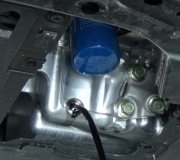First, do a compression test to verify the motor is good.
Then check the plugs, boots coils and the cap for cross fire marks.
Common on these motors for miss fire are the cap carbon tracking, coil failures and the module on top of the cover assembly.
Circuit Description
The electronic Ignition Control Module (ICM) sends a reference signal to the Powertrain Control Module (PCM) seven times per crankshaft revolution to indicate crankshaft position and RPM so that the PCM can determine when to pulse the ignition coils and control the ignition timing. This signal is called medium resolution (7X reference) because it occurs seven times per crankshaft revolution. The ICM applies 5 volts from terminal G through the 7X reference circuit to PCM terminal C2-32 and, in effect, switches this circuit to ground for a very short period of time. The seventh pulse is the sync pulse and is used for crankshaft position reference.
Conditions for Setting the DTC
PCM sees more than 15 Crankshaft Position (CKP) sensor resync's in 255 seconds (4 minutes and 15 seconds).
Action Taken When the DTC Sets
The Malfunction Indicator Lamp (MIL) will illuminate.
The PCM will record operating conditions at the time the diagnostic fails. This information will be stored in the Freeze Frame and Failure Records buffers.
A history DTC is stored.
Coolant fan turns ON.
Conditions for Clearing the MIL/DTC
The MIL will turn OFF after three consecutive ignition cycles in which the diagnostic runs without a fault.
A history DTC will clear after 40 consecutive warm up cycles without a fault.
DTC(s) can be cleared by using the scan tool.
Diagnostic Aids
If the complaint was Cranks But will Not Run, DTC P0335 may be set when attempting to start the engine more than 15 times and the ignition is not turned OFF between attempts.
An intermittent problem may be caused by a rubbed through wire insulation or a poor connection.
Any circuitry, that is suspected as causing the complaint, should be thoroughly checked for the following conditions:
Backed out terminals
Improper mating
Broken locks
Improperly formed
Damaged terminals
Poor terminal to wiring connections
Physical damage to the wiring harness
An intermittent can also be the result of a defective reluctor wheel. Remove the crankshaft sensor and inspect the reluctor wheel through hole. Check for porosity and condition of wheel.
Test Description
Number(s) below refer to the step number(s) on the Diagnostic Table.
The Powertrain OBD System Check prompts the technician to complete some basic checks and store the freeze frame and failure records data on the scan tool if applicable. This creates an electronic copy of the data taken when the fault occurred. The information is then stored on the scan tool for later reference.
This step determines if the PCM is recognize a problem. If the DTC doesn't reset at this point, the problem may be intermittent.
When a Med. Resolution Resync occurs, engine stumble should also occur. If a component connection or wire is at fault, an engine stumble or a medium resolution resync may be induced by wiggling the circuit or connector.
Operating faulty non-engine related electronic components may emit Electromagnetic Interference (EMI) which may cause a resync. This step will determine if the medium resolution resync's are being caused by an outside source.
Any circuitry, that is suspected as causing the complaint, should be thoroughly checked for backed out terminals, improper mating, broken locks, improperly formed or damaged terminals, poor terminal to wiring connections or physical damage to the wiring harness.
An intermittent problem may be caused by a rubbed through wire insulation or a poor connection.
A code never identified a bad part, just a failed system.
Roy
Sunday, January 13th, 2013 AT 2:06 PM




